Key Takeaway: Improving bus stop amenities includes increasing the quantity and quality of shelters, seating, lighting and real-time customer information at all stops, prioritizing high ridership stops. Challenges to installing shelters include the complex approval process and community concerns with shelters related to personal security.
Use these links to jump to sections on this page:
Bus Stop Types
Shelter Types
Seating and Lighting
Bus Shelter Cleanings
Shelter Placement, Replacement, and Removal
Bus Shelter Seating Analysis
Gimme Shelter! Campaign
Muni’s bus system provides service to all areas of San Francisco. Bus stops are located on the street, often spaced 2-4 blocks apart. Bus stop amenities that contribute to the accessibility of the Muni system include shelters and seating, signage, lighting, and customer information. Currently, it is our goal to provide shelters at bus stops with 125 or more daily boardings. As of August 2024, approximately two-thirds of these high-volume stops also have shelters.
Most bus stop amenities are provided through our shelter contract with Clear Channel Outdoor. This contract allows Clear Channel exclusive access to advertise at our bus stops in exchange for installing and maintaining all Muni transit shelters. Per the contract, each shelter where a power supply is available must provide Next Muni arrival data, a system map, and the Push to Talk system for our visually impaired passengers. Clear Channel owns each individual shelter and maintains them.
The Transit Shelter Advertising Agreement between the SFMTA and Clear Channel began on December 10, 2007, for a term of 15 years, and was extended to December 7, 2027, in 2022. Due to negative financial impacts from the COVID-19 pandemic, the contract extension requires Clear Channel to provide increased regular maintenance of the shelters and a “Shelter Refresh” capital campaign. Moving forward, the SFMTA will need to allocate resources and funding in anticipation of the end of the contract with Clear Channel.
The SFMTA is working on an updated inventory of stop amenities across the Muni bus system. Data collection efforts will focus on stop type, presence of shelter, shelter type, presence of curb ramps, and amount of seating. This information will help the SFMTA identify and address bus stops for improvement.
Bus Stop Types
Bus stops are categorized by four main types — Bus Zone; Bus Bulb; Transit Island; and Flag Stop — and feature a variety of amenities that are critical to the accessibility of the overall system, such as seating, shelter and real-time arrival information.
Bus Zones
Bus Zone stops allow a bus to pull out of traffic and stop right at the curb so passengers can board and alight directly to and from the sidewalk. The zone is marked by red curb along the entire length of the curb and denoted by a “bus box” which is a painted white rectangle to designate the space only for buses. Often found at our highest use stops, many bus zone stops have amenities including shelters, benches and real-time arrival information.
Figure 1. An SFMTA Bus at a Bus Stop
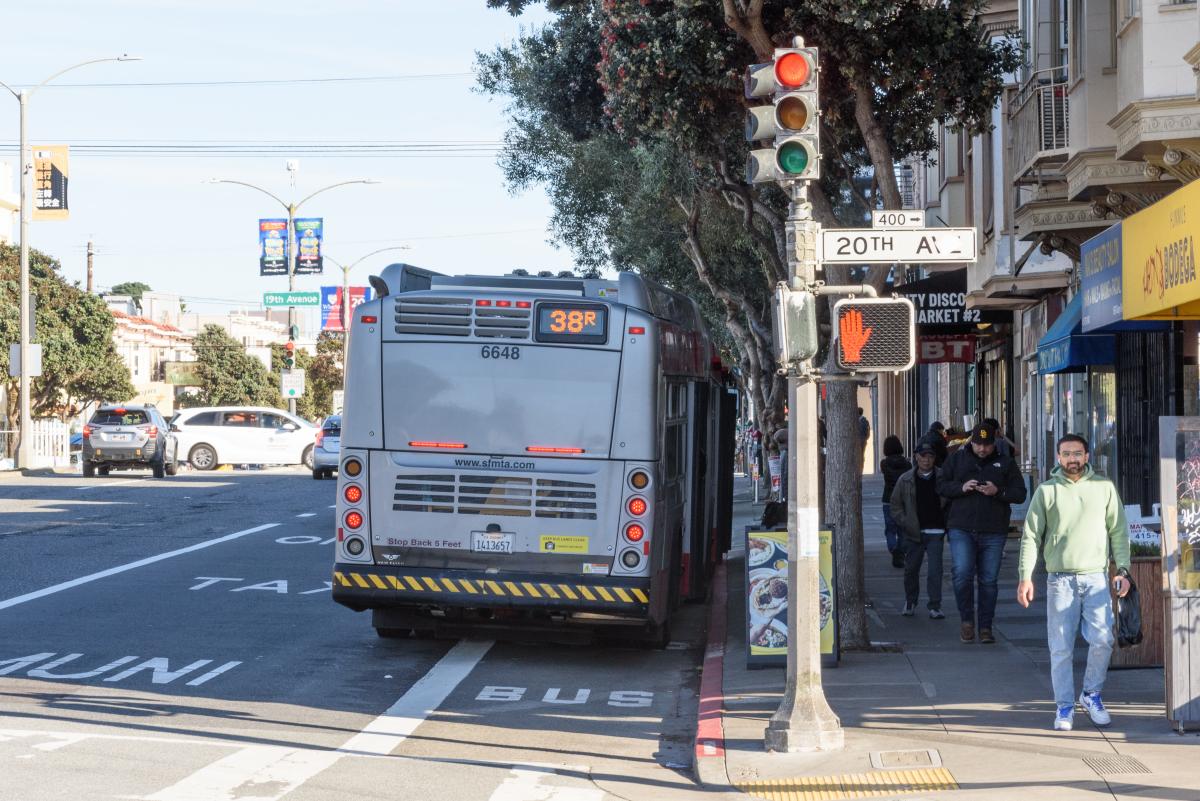
Bus Bulb
Similar to a bus zone, these stops consist of a sidewalk extension, running the entire length of the bus which allows the bus to stop in the traffic lane while still being able to board and alight passengers directly onto a curb. The wider sidewalk width provided by the bulb often allows SFMTA to provide shelters, seating, bike racks and other amenities at these locations to improve passenger comfort. These are often located on our most high use routes and at our most high use stops.
Front Door Only Bus Bulb: A variation on the bus bulb, these stops consist of a smaller sidewalk extension, designed to serve only the front doors of a bus. The extension is usually designed so it is slightly wider than the front doors of the bus. Typically measuring between 8-12 feet in width, these are used at locations where we would want to place a full-sized bus bulbs, but nearby constraints make it hard to do so.
Figure 2. An SFMTA Bus at a Bus Bulb
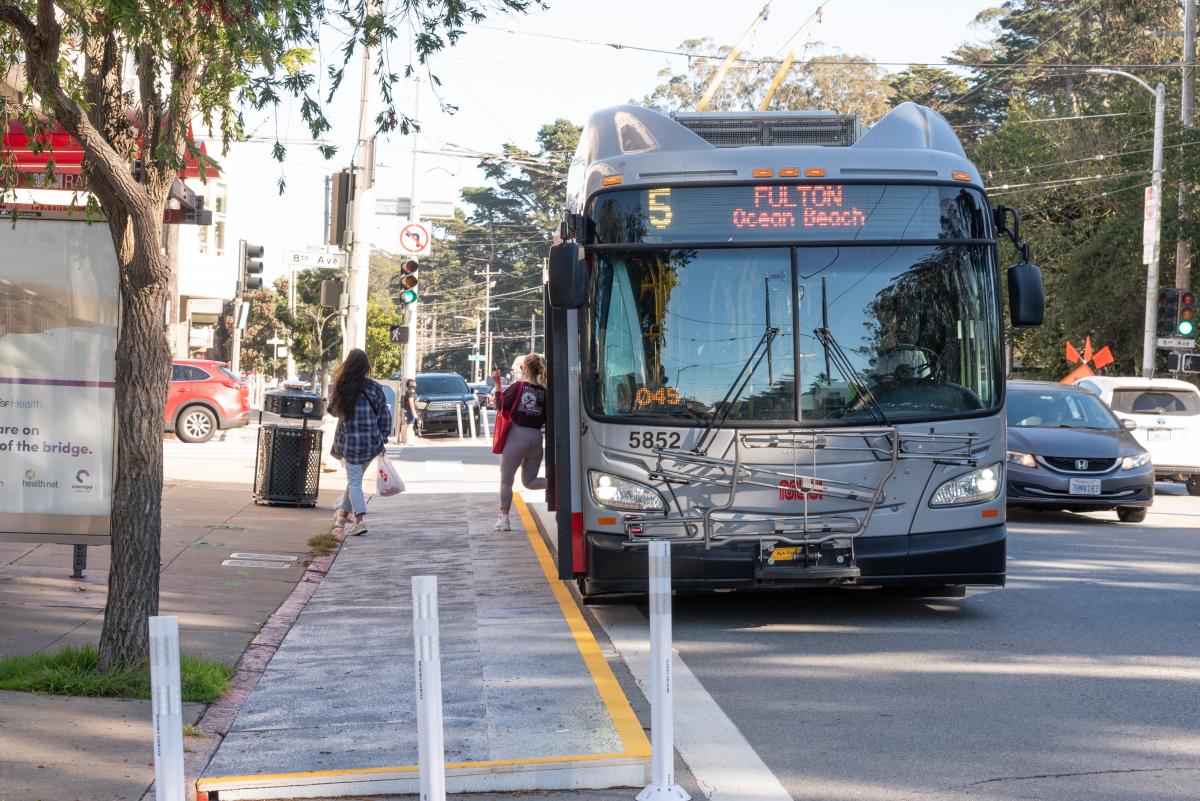
Transit Island
Located in the street, transit islands are free-standing low level concrete platforms that are least 8 feet wide and at least 150 feet long with a 6-8-inch height. Some islands are as low as 2 inches where required by the Fire Department. Islands are generally located at intersections and are accessible via ramps that are perpendicular to the crosswalk. Islands may be in a center lane or in a curb lane. On some streets the center lanes are painted red and designated “Bus Only.” Some curb lane islands are adjacent to dedicated bike lanes and in some cases are mid-block with pedestrian crossings.
Figure 3. An SFMTA Bus at a Transit Island
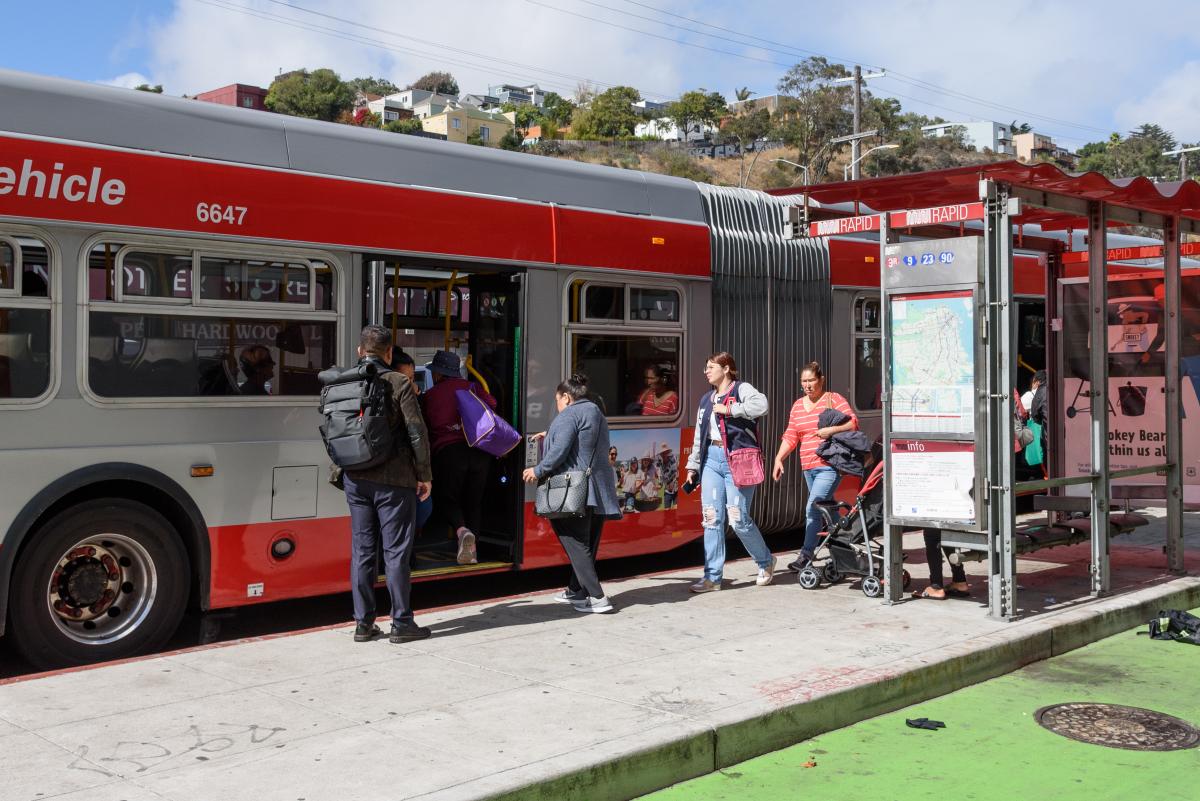
Flag Stop
Flag stops are locations where the bus stops in the travel lane instead of the curb. The adjacent curb at these locations is allowed to be used for other uses, such as parking or parklets. They are marked by either a rectangular yellow “stop bar” painted on the pavement or by a yellow ring painted on a nearby utility pole. Few flag stops have amenities, though some do have transit shelters and/or benches. Flag stops are generally located in residential areas at stops with a low volume of ridership.
Figure 4. An SFMTA Bus at a Flag Stop
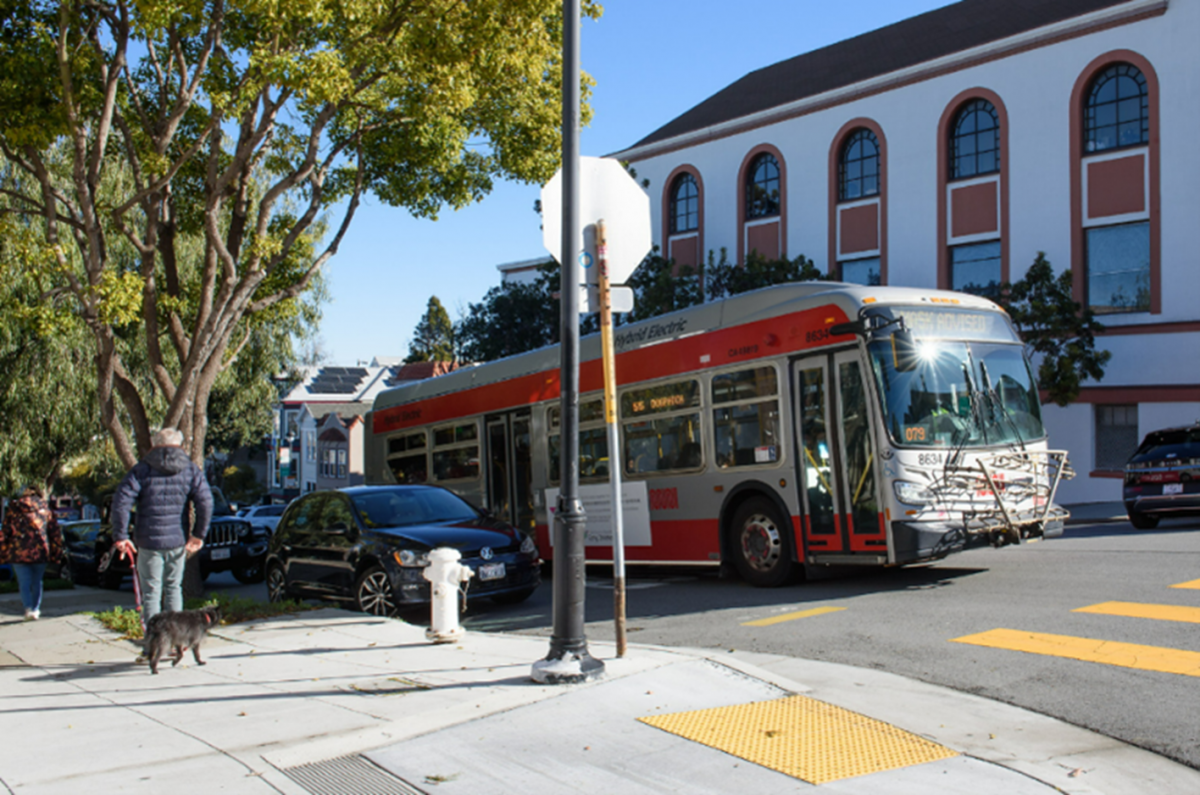
Shelter Types
The SFMTA provides transit shelters throughout San Francisco to ensure that transit customers have a comfortable area, protected from the elements, to wait for transit vehicles. Transit shelters fulfill an important wayfinding function by making transit stops more visible and providing a hub for critical customer information, such as a system map, real-time vehicle arrival information, specific route/line information, and service hours.
Muni shelters are divided into four main types — Standard Shelters; Standard Non-Ad Shelters; Alternative Shelters; and Cantilever Shelters. At locations that have access to electrical power, shelters provide real time passenger information through our NextMuni customer information system, as well as a text to audio Push-to-Talk system, which audibly announces information displayed on our customer information screens to passengers who are unable to view the screens. Clear Channel owns each individual shelter and maintains them. There are roughly 1,243 shelters, of which about 809 are powered and have Next Muni displays.
Standard
A shelter consisting of between 2-6 seats, roof, Muni information kiosk and ad panel. If powered these shelters also have a customer information screen, push to talk system, and lighting.
Figure 5. A Standard SFMTA Bus Shelter
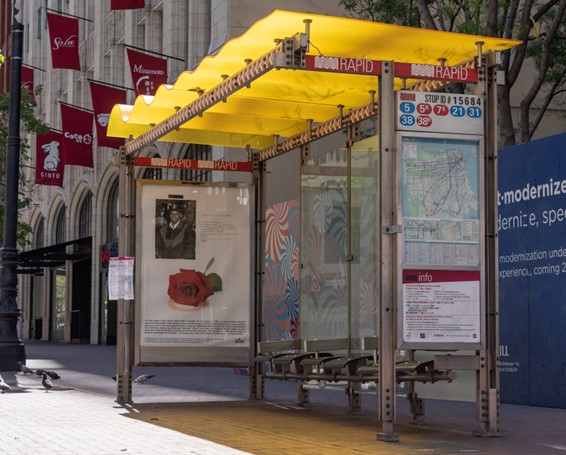
Standard Non-Ad
Same as above except the ad panel is not present. This allows for a narrower shelter that can be placed at more constrained locations.
Figure 6. A Standard Non-Ad SFMTA Bus Shelter
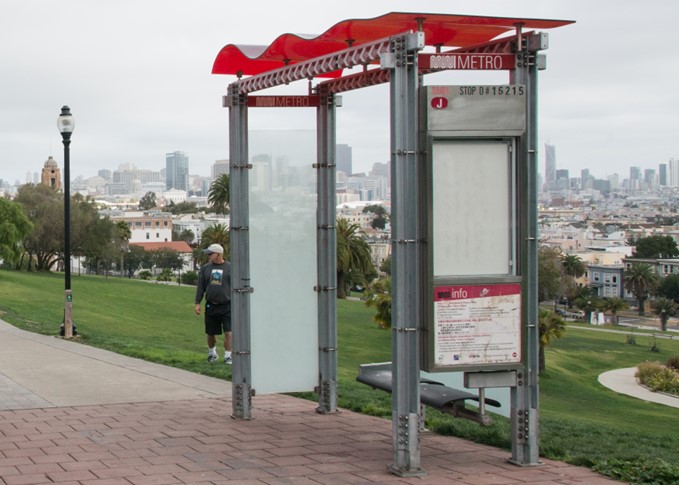
Alternative
Similar in function to a bench, these are located at our most constrained stops, and consist of two seats affixed to a flat panel which includes an advertising space as well as a Muni information kiosk and when powered, a customer information and push to talk system is provided.
Cantilever
Our narrowest shelter, the cantilever shelter consists of a roof supported by a metal structure. Seating is not provided. These are often located on narrower transit islands found on our Metro system and along Market Street. Some locations can support a customer information display.
Figure 7. A Cantilever SFMTA Bus Shelter
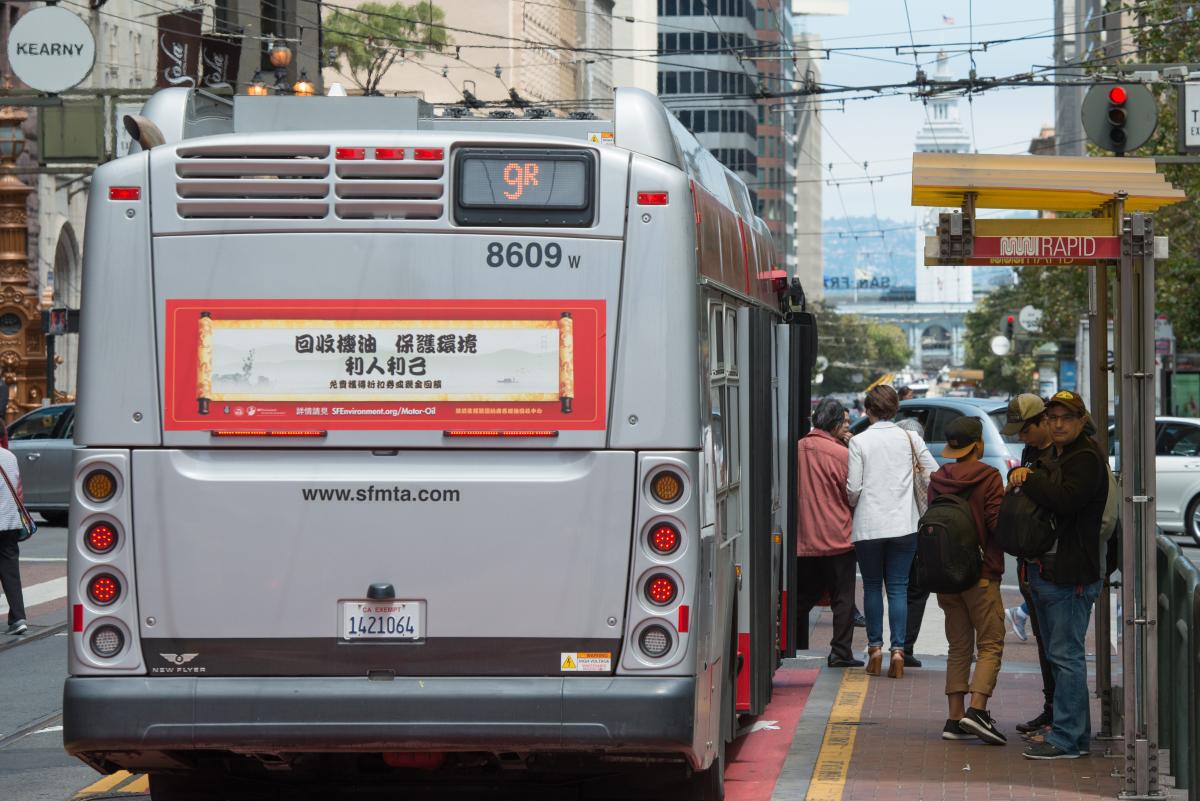
Seating and Lighting
There are 1,064 bus shelters in the system that provide seating. Stops with cantilever shelters or without any shelters do not typically provide seating, although the agency has installed a limited number of benches at locations that, for various reasons, cannot support a shelter but where seating has been requested. Similarly, lighting is provided at the approximately 1,031 stops with shelters and electrical power.
In the 2014 SFMTA Accessible Services Strategy Survey, several comments asked for benches at more bus stops. More than a dozen comments suggested that the agency could “make bus stops safer and more comfortable by” improving or installing lights at bus stops. One comment mentioned, “some of [the] bus stops do not have proper lighting for passengers at night,” and another suggested that the SFMTA should “provide lights at stops in darker areas so that the stops feel safe.”
Bus Shelter Cleanings
In 2023, there were, on average, over 15,000 baseline shelter cleanings per month performed by Clear Channel. From July 1st-December 31st, 2023, there were an average of 313 work orders completed per month. This included 379 work orders related to lighting, 739 related to glass replacement, and 67 related to seat replacement. During the same period, Clear Channel took an average of 17 days to respond to lighting-related work orders and 5 days for both glass and seat replacement work orders. As of December 2023, Clear Channel employs 13 cleaners, 8 maintenance persons, and 2 subcontractors to complete this work. These numbers underscore the amount of time and resources needed to maintain the agency’s transit shelters.
Figure 8. Shelters by number of times cleaned, monthly (1/2023-1/2024)
Shelter Placement, Replacement, and Removal
It is the SFMTA’s goal to provide shelters at all high ridership bus stops, defined as 125 or more riders boarding daily. We also consider requests to install transit shelters from the community. Once proposed by the SFMTA, shelters must be approved in a public hearing by San Francisco Public Works before we can install them. The speed of this process depends on Public Works staff capacity. During the height of the COVID-19 pandemic, public hearings were suspended and resulted in a backlog. In addition, community members are not always supportive of adding shelters at high ridership stops and therefore are not always approved.
It is also the SFMTA's policy to keep in place all shelters that have been installed. The SFMTA only considers the removal of a transit shelter when either a hazardous situation, like a construction project, public health threat, or a disability access issue is identified and cannot be addressed through enforcement or an adjustment at the existing shelter site to improve access.
The SFMTA’s policy requires any transit shelter removal to be preceded by a public hearing, which provides an opportunity for the public, including seniors, people with disabilities, or others who are concerned about accessibility issues to provide comments.
The SFMTA may also hold a community meeting prior to the public hearing to collect more information about community concerns and to discuss possible solutions. The Director of Transportation is responsible for making the final determination as to the removal of any transit shelter after receiving the recommendation of the hearing officer.
Bus Shelter Seating Analysis
In the summer of 2024, Staff in Accessible Services analyzed seating and shelters at bus stops with 125 or more boardings per day to determine which high-use bus stops currently lack shelters. The findings reveal that the total number of stops with ridership above 125 riders is 869. Of these bus stops, approximately one-third of these stops were shown not to have a shelter, according to data from Clear Channel.
High ridership stops that don't have a shelter ID attached to them — meaning an unknown or no shelter — are not necessarily geospatially concentrated. High ridership stops that are known to have shelters but not any seating are generally concentrated along Market St., Fisherman's Wharf, and Judah St., with smaller concentrations along Church St. and near Balboa Park. On the other hand, high ridership stops with only two seats don't seem to be concentrated in any particular point in the city.
Figure 9. Map of High Ridership Bus Stops with Inadequate Seating
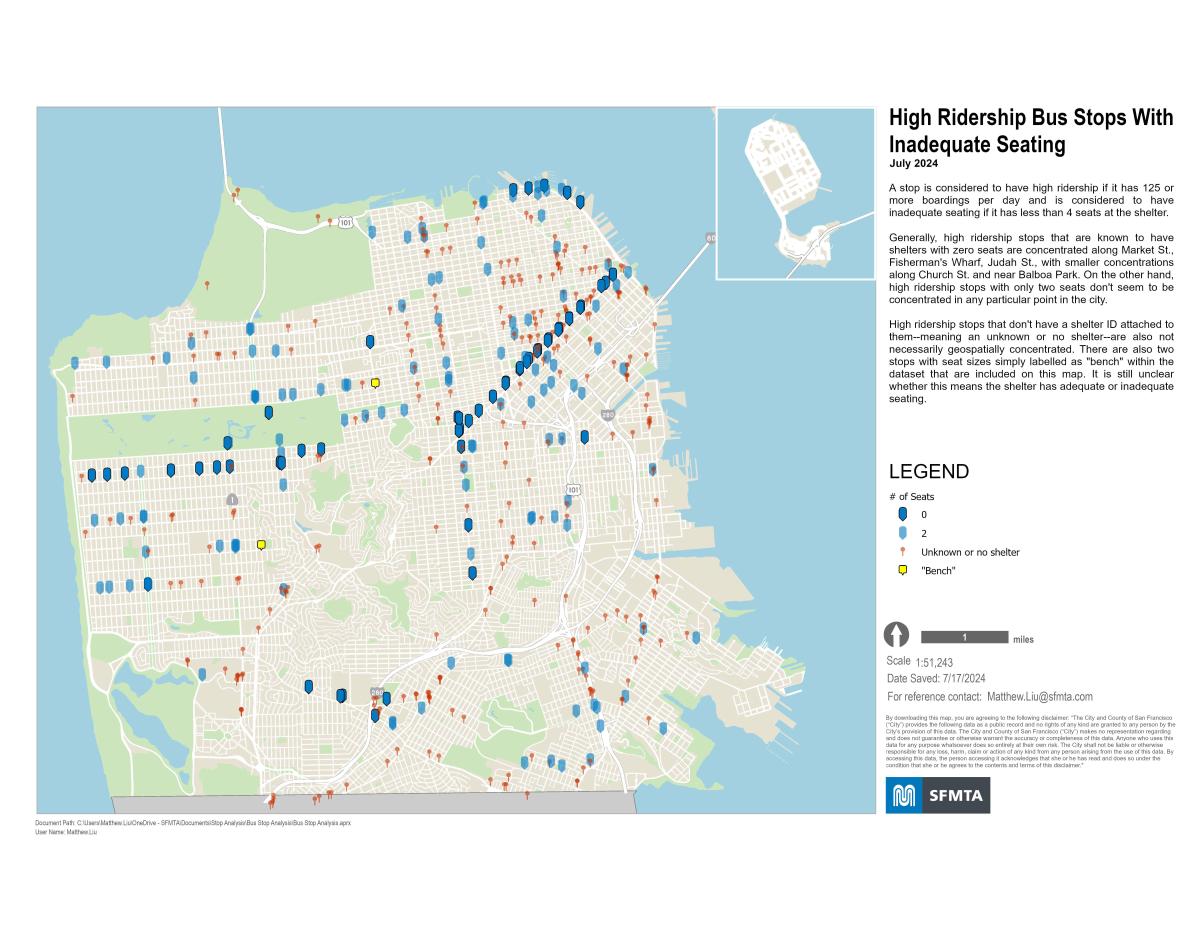
Senior and Disability Action’s Gimme Shelter! Campaign
Senior and Disability Action, a San Francisco-based organization that mobilizes older adults and people with disabilities to fight for social justice, operates the Gimme Shelter campaign to demonstrate that transit accessibility begins at the bus stop. A key premise of the campaign is that a lack of seating at a bus stop can prevent older adults and people with disabilities from riding the bus, forcing them to find an alternative transportation mode or cancel their trip. As part of the campaign, Senior and Disability Action administered a survey in 2022 to understand the value of bus shelters and seating for vulnerable San Francisco residents. About 48% of the 240 respondents reported that the bus stop nearest to their home does not have a shelter with seating, and the organization is calling for more and improved bus shelters throughout the city.
Half of the survey respondents reported they were 65 years or older, 10% indicated a disability, and 34% were both over 65 and a person with a disability. Just 43% of people surveyed reported they could comfortably walk more than 3 blocks, and only 28% could comfortably stand at a bus stop for more than 10 minutes. Limited mobility means that nearly a third of respondents often wait for a bus longer than they can comfortably stand. For many, shelters are a necessity: about 42% of people surveyed said they need a shelter in order to wait for a bus, and 39% required a shelter depending on weather or health. Similarly, seating is a necessity for 38% of survey respondents when waiting for a bus. In addition to the survey, 51 people signed the Senior and Disability Action’s petition, which states that “all surface level bus stops should have a bus shelter with seating, audible and visible display of the next bus estimated arrival time, and route maps.”
Figure 10. Survey responses to the question "How often do you wait for a bus longer than you can comfortably stand?"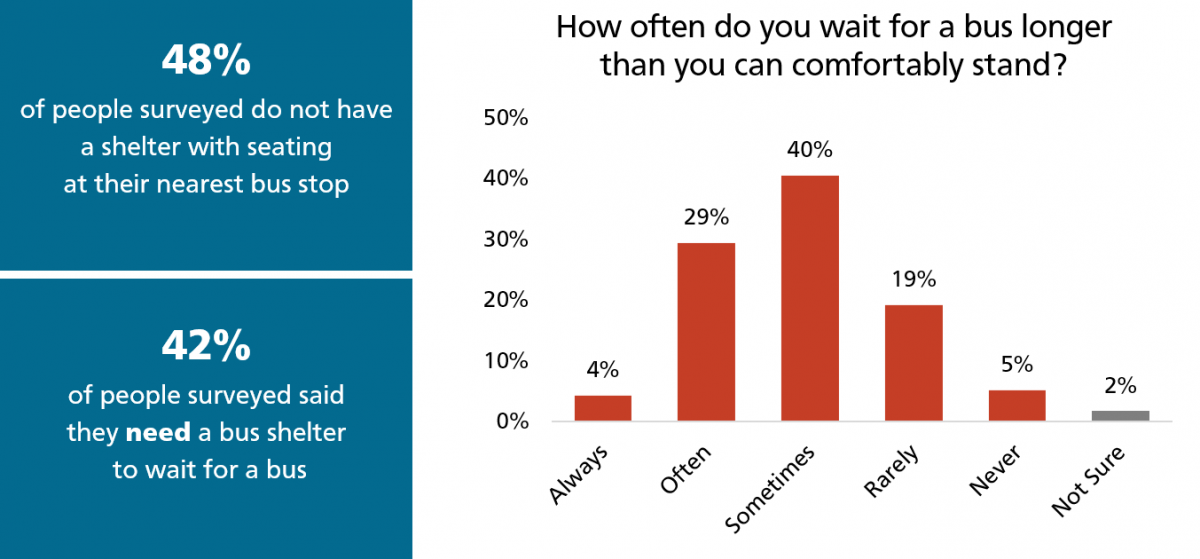
Accessible Text for Figure 10.
